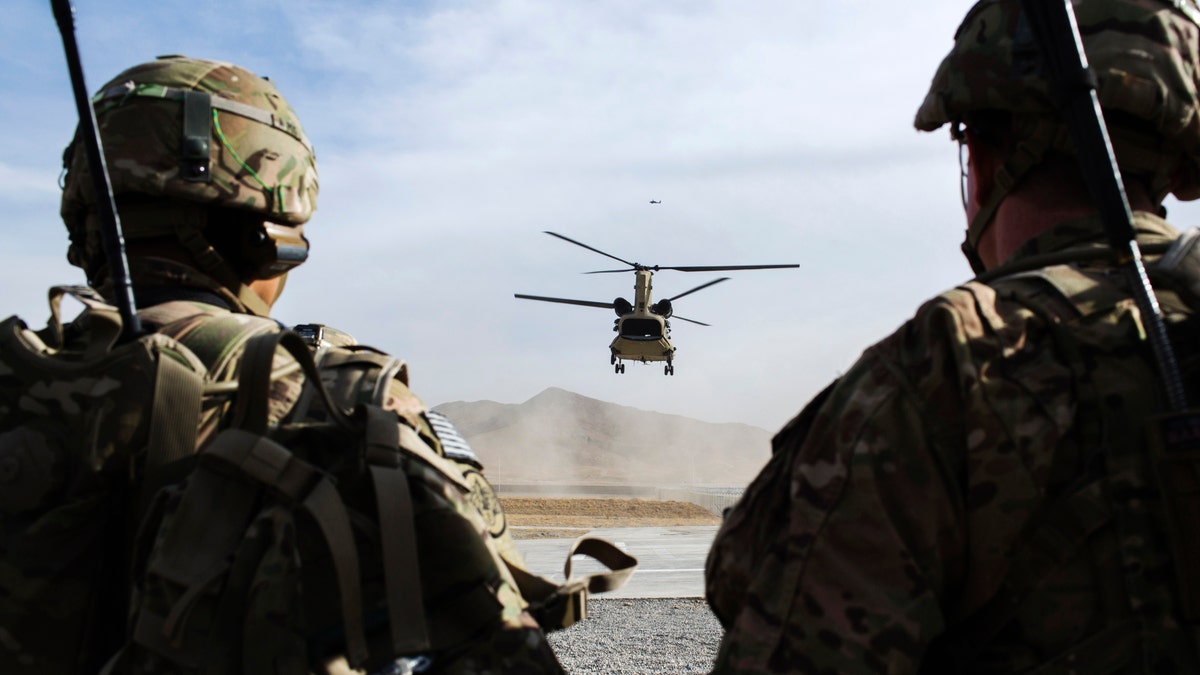
File photo - U.S. soldiers from the 3rd Cavalry Regiment watch as CH-47 Chinook helicopter from the 82nd Combat Aviation Brigade lands after an advising mission at the Afghan National Army headquarters for the 203rd Corps in the Paktia province of Afghanistan December 21, 2014. (REUTERS/Lucas Jackson)
The U.S. military needs new messaging technology that’s ultra-secure and self-destructs. Sound familiar?
Think SnapChat. That’s an important part of what the Defense Advanced Research Projects Agency (DARPA) is aiming to do via a request for proposals posted on a DOD Web page. In Phase III of the project, DARPA says it requires “a secure messaging system that can provide… one time eyes only messages,” among a host of other features. Similarly, SnapChat allows a message to be viewed for a short length of time (1 to 10 seconds) before it becomes inaccessible, the primary reason it has become such a popular messaging platform.
Beyond this, the larger objective for the military is to meet a “critical DoD need to develop a secure messaging and transaction platform." The DARPA request for proposals is aimed at building a messaging platform that the military could use for secure communication ranging from procurement to intelligence.
Related: Australian computer scientist Craig Wright says he created Bitcoin
To prevent cyberattacks and build a more secure platform, DARPA is eyeing a messaging service that not only taps standard encryption used by other secure messaging services like WhatsApp but also communicates via a decentralized protocol like blockchain. The latter is one of the main features of Bitcoin and acts as a public ledger of all Bitcoin transactions.
Security experts say that blockchain could provide big benefits to the U.S. military.
Kevin Shahbazi, CEO of cloud-based security specialist LogMeOnce told FoxNews.com that because messages and transactions are distributed and not kept in one central location, hacking is very difficult and is detected immediately, making blockchain transparent and more trustworthy. “This is a fantastic move, and will pave the road for many entrepreneurs to roll up sleeves and start contributing to this sector,” he said, via email. “DARPA’s task is significant, and it will help the market overall.”
Related: Meet the military's new $1 billion jammer
“Blockchain protocols are a new class of protocols that are extremely resilient to attack – they gain that resiliency by virtue of being decentralized,” added Emin Gun Sirer, associate professor of Computer Science at Cornell University. “It’s wonderful to see the government take an active interest in a very happening and very hot area of computer systems.”
IBM, for example, is also ramping up its efforts around blockchain. The tech heavyweight recently launched a new framework for securely operating blockchain networks, as well as new services that harness the protocol on the IBM Cloud.
“[DARPA] is dipping their toe into blockchain technologies because they realize that there is a lot of interest in them in industry,” Cornell’s Sirer told FoxNews.com. “Blockchain can have a lot of military uses – presumably, these secure messaging services would let people in the field communicate with others without going through a command control center.”
Related: This huge combat tractor is the ultimate multitasker
One key element of DARPA’s request for proposals addresses the needs of “troops on the ground in denied communications environments.” They “would have a way to securely communicate back to HQ and DoD [that is]…safe from hackers.”
Other highlights of DARPA’s request include data that “can be instantly and securely sent and received thereby reducing exposure to hackers and reducing needless delays in DoD backoffice correspondence,” the DARPA document states. “As an example, Military Interdepartmental Purchase Requests (MIPR) could be implemented using the secure ledger. Regulators…could… easily verify that a MIPR transaction didn’t violate Federal Acquisition Regulations (FAR).”
In a Q&A update posted April 27, DARPA states it has created a new blockchain technology.
Related: New tech gives US helicopter pilots 'Superman-style' vision
However, there is a question mark over whether blockchain technology will be scalable enough for the military, which has vast communications networks. “The problem is that there’s a lot of delay in the [blockchain] system,” Roger Kay, president of tech research firm Endpoint Technologies told FoxNews.com. Bitcoin, which is the most commercially advanced blockchain in existence, experiences transaction delays, he noted.
Sirer told FoxNews.com that, even if DARPA’s new blockchain-based messaging system does not materialize, aspects of the technology could find their way into other projects. “DARPA funds a lot of forward-thinking projects – even if the deliverables are not immediately usable, the knowledge gained rolls into the next thing, which rolls into the next thing, which rolls into The Next Big Thing.”
There are three phases to the DARPA project, as currently proposed.
Phase I: “Create a specific decentralized messaging platform built on the framework of an existing blockchain framework.” Phase II:” Develop, test and evaluate a working prototype.” And Phase III: "focus on commercialization and full-scale implementation of the platform.”
